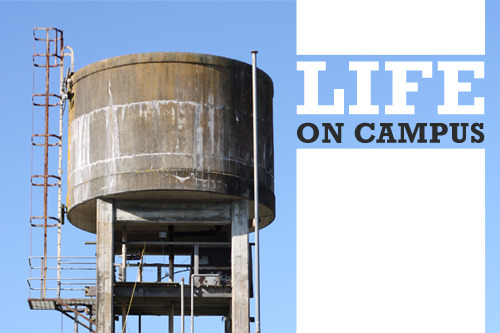
This year I enrolled at Camp for the very first time.
Campus A Low Hum, fondly known as Camp or CALH, is a dream music festival held at Flock House in Bulls annually. 1,500 people from all over New Zealand, and the world, descend on Bulls for four nights, three days, of creativity – including both music and art.
Camp is a dream in the sense that it incorporates everything that it’s founder, Blink, desires for a music festival – great music, likeminded people, in a fantastic atmosphere.
The event is all ages, attendees can cart in as much alcohol as they like, bands aren’t scheduled to clash with each other, there’s a minimal security presence, and everyone has the same status – there are no VIP passes, and it’s not uncommon to find yourself rubbing shoulders with the musicians around Campus.
Having begun as a true camping music festival in 2007, the event moved to Flock House in 2010; the old agricultural school provides the ideal backdrop for the experience – the Gym, the Dorms, the Barn and the empty swimming pool are just a few of the epic “stages” used on campus.
Blink (Ian Jorgensen), responsible for music promotions as A Low Hum from Wellington, hand picks the artists for each year’s camp. This lineup is completely unannounced by the organizers, and includes bands from New Zealand and Australia as well as international acts from far further afield. The event is a sell-out, proving the faith the audience has in Blink’s curation.
For my first Camp this year, I was in the fortunate position to be “in between jobs” quite literally, and on a two week break. Having seen some of the artists billed to be playing in New Zealand at the time, my biggest hopes were that Four Tet and Caribou (both playing Splore City in Auckland the same weekend) would come along. Also, after an incredible show on the 6th of February, I wasn’t the only one dreaming of seeing Sufjan Stevens again at Camp.
I planned to go along with a friend, Nicki, who has been before, hoping to leech some inside knowledge (and a sleeping spot in the dorm she had to share with her friends!). Laura, a good friend of mine from Wellington was also keen to get to Camp – but struggling on a student budget. I picked up her ticket as a birthday present, and she and I made our way from Wellington to Bulls by bus on the Thursday afternoon.
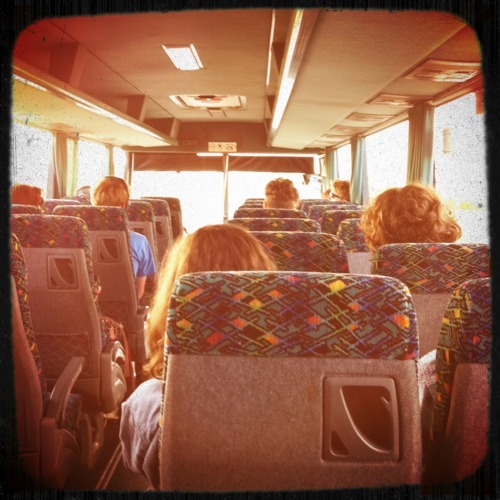
The bus from Wellington.
The bus was full of others quite clearly heading to camp – from the loud conversation of excited exhibitionists, we gleaned that three people within earshot had come over from Australia. The exuberant redhead a few seats in front skipped no detail in describing how well CALH compared to the many international festivals she had clocked up in the past few years.
After a couple of hours watching corn fields and farmland fly by, we arrived at the Bulls information center/bus depot where the CALH website had promised would be shuttles running to Flock House every hour. You can’t mention Bulls without bringing up the saturation of “bull” puns in the place: the Bulls Eye cafe, Adorabull childcare center, “constabull” written over uniformed bull imagery on the police station. I swear I only cracked a joke once – “it’s indescribabull” to a couple of guys also waiting for a shuttle to Camp. They were suitably impressed, lucky I got in early.
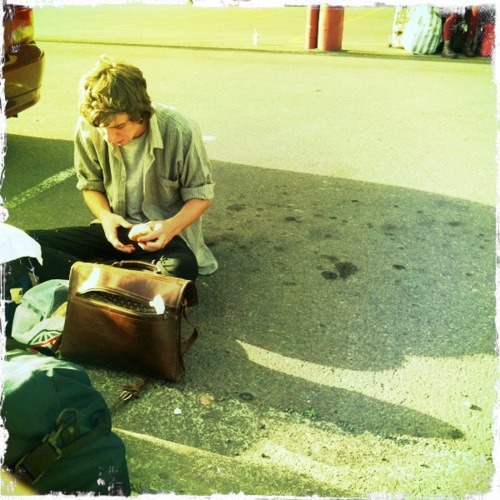
Waiting for shuttles at the bus depot in Bulls.
We spent an hour and a half of sitting on the curb beside NZ’s first drive-thru Subway outlet (true story), before managing to jump in the shuttles to Camp. Laura and I had to split between the two vans to fit with the other groups of people from our bus, giving me an opportunity to chat to the others in the van.
Our driver, David, described himself as Blink’s backup guy – being wherever Blink couldn’t be. Also from Wellington, David told us that Camp was going to be incredible and that we were wise to get along while it was still running in it’s prime – these things don’t last forever.
The rest of the van was full of young people from Melbourne, who came based on one friend’s rave review of last year’s trip. We were all uninitiated, and we were all excited.
After picking up our wristbands and booklets at the gate, we dragged our gear towards Wilson House, where our dorm room waited. It was hard not to scan the timetable for Caribou, Four Tet, and Sufjan but we heard a girl cooly saying to her friend at the entrance that “of course Caribou and Four Tet are here, I knew that already”. Excellent.
We explored the rundown building of Wilson House, then sifted through our timetables. Names I knew included Liam Finn, Pikachunes, High Places, Toro Y Moi, Dear Time’s Waste, Grayson Gilmour, the Drabb Doo Riffs, Bachelorette, Disasteradio, Lawrence Arabia, Leno Lovecraft, and of course Four Tet and Caribou. I couldn’t help myself, and sent a gloating text message to my very jealous friend Pat, and an “I’m here!” announcement on twitter before ditching my phone, and we were into it.
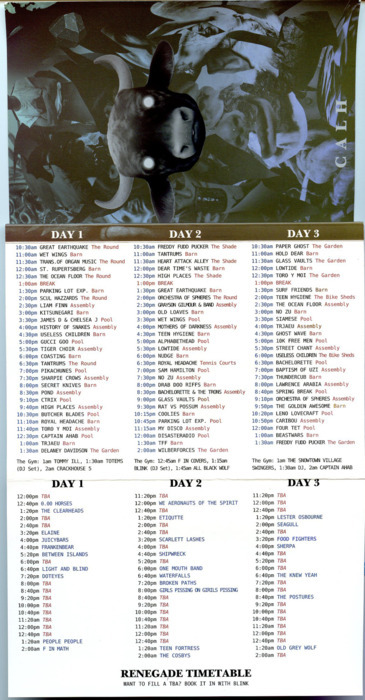
Scan of the CALH booklet cover, showing the main and renegade timetables.
I’ve listed the bands on the lineup I recognised, but that’s far from the point of Camp. The very best part is the bands you don’t know and subsequently discover as you make your way around Campus.
After spending our first night on the floor, and enjoying a morning of cold showers and delicious bacon and egg baps at the catered “restaurant”, the first musical hit with us was The Ocean Floor, a quartet who’s musical roots took hold in Florida.
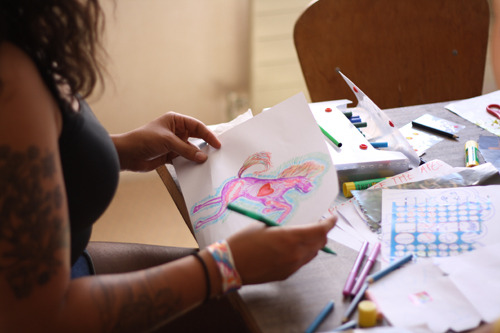
One of the girls from The Ocean Floor draws a unicorn.
The combination of sweet harmonies and some melodic Andrew Bird-esque violin plucking had me hooked. Laura and I were delighted to be later joined by three of the four in the Arts and Crafts room after their set, where we made posters of narwhals and unicorns and talked about the sea, Portland, and Hamilton. You can check out their music on their myspace page.
Next door to Arts and Crafts was the Camera Obscura room – where we chatted with other photo people about techniques and crafty photo tricks before playing with a pinhole at the window.
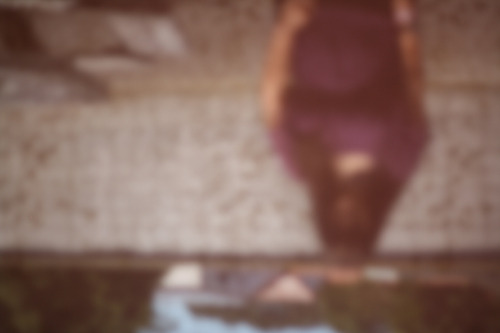
Camera obscura image of me, so upside down and textured with wallpaper.
When the heat of the Camera Obscura room became unbearable, we made collages. I was that caught up in my collage making, we completely missed seeing Liam Finn.
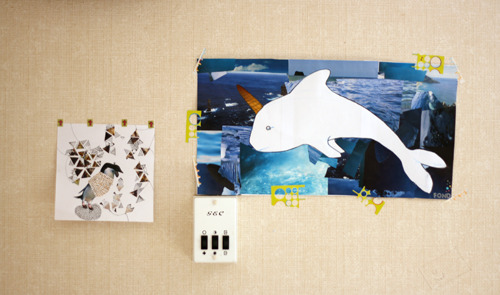
Lauras penguin and my narwhal poster.
By the time we finally hauled out of the drawing room it was time to find something cold and alcoholic and get into the music again. Equipped with a picnic blanket and a very strong mix of “Chocolade” and vodka, we fell in love with Tiger Choir.
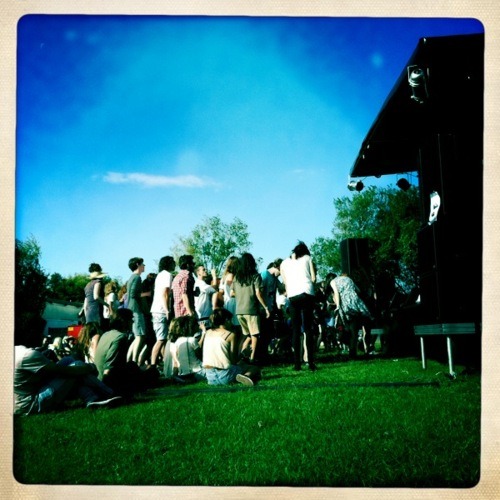
The crowd loving Tiger Choir.
Their energy on stage and ravepop sound was an instant hit with me, and judging by the cheers from the audience and the crowd of dancers I wasn’t alone. The three Hobart boys have some self produced material up on their bandcamp page, and I recommend you take the time to listen.
The next notable was Pikachunes in the swimming pool. I can’t count the strange looks I’ve had from people confused by the concept of a band playing in an empty swimming pool. It was my favorite stage, with the pool bottom forming an ideal dance floor with the band in the heat of it.
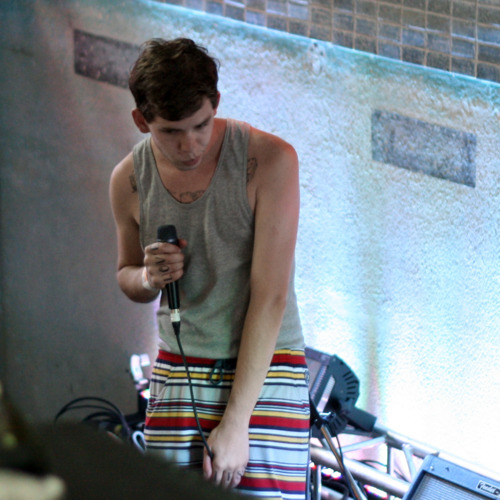
Pikachunes at the start of his set.
There was plenty of sitting and standing room around the perimeter of the pool for anyone just wanting to watch, and as we were indoors – the light projections were magical.
Pikachunes had an amazing set. We dove in to the dance floor and moved like wild things with the rest of the crowd. It was loud, it was joyous, it was uninhibited, it was like nothing else. Pikachunes is from Christchurch and produces all manner of electronic goodness.
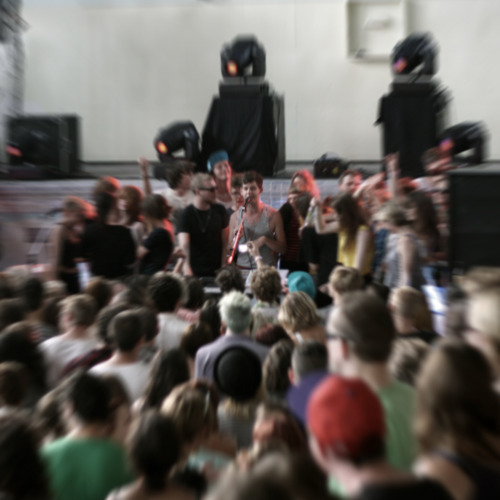
Pikachunes in the pool.
Somewhere about this time Nicki and I struggled to find the ladies room, and so startled a few intoxicated guys when we invaded their bathroom in search of a cubicle. We were very friendly and polite in our invasion though – “Hi Tim!” “Hi, er, this is awkward”. No one really cared, this is Camp, anything goes.
Emerging into the daylight after this first pool adventure was jarring, and I couldn’t wait for the next two bands to finish so we could head back inside for cTrix.
cTrix I hadn’t heard of before, but his writeup in the CALH booklet was promising, describing live sequenced electro tunes raw from their outputs – most prominently the Commodore’s Amiga and 64. I don’t claim any real familiarity with the Commodore Amiga or the 64, but I recognized at least the Sega and GameBoy sounds in his mixes.
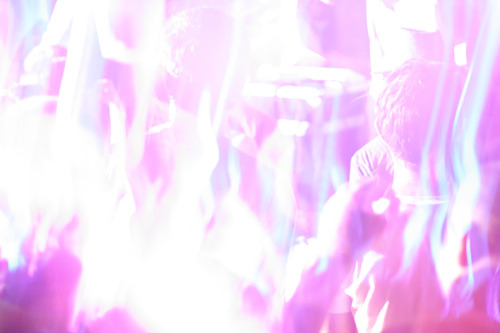
Taking photos while dancing in the pool to cTrix results in this.
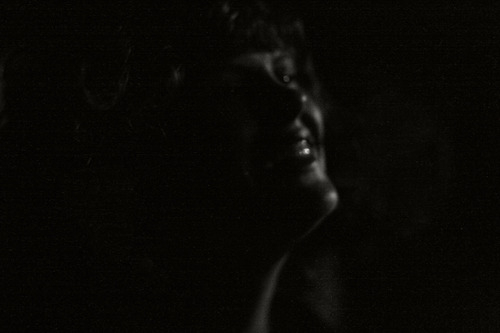
I caught this profile of another girl dancing to cTrix, I love her expression.
The crowd just loved cTrix, going crazy for the more familiar tunes and flooding the stage to dance. It was magic. If you, like me, hadn’t heard of cTrix and consider yourself a bit of a computer freak/electro lover, check out his stuff.
Later that night Toro Y Moi played. They weren’t bad, but not the highlight of my night. More a box to check than anything else. Right after them though, it was back to the marvelous Pool for Captain Ahab.
I’d not come across Captain Ahab before either, but prior to their show overheard a few excited people around Campus. The booklet told us that they are Jonathan Snipes and Jim Merson from Los Angeles. “Jonathan physicalises the songs with aggressive "take off your pants” dancing action“. Sounds intense.
Their spin was that guilty pleasures shouldn’t be guilty, and that "coolness” is fickle. Their reinterpretation of irony serves to ask people “not to get all judgy-pants” because they’re just having fun. And fun they had – in front of a projection of eccentric, bright, colorful and fitful scenes and an intense lightshow, Jonathan raced through, around, and above the pool leading the crowd in a schizophrenic rave to the music.
From the back of the room we had a perfect view of the madness and loved every minute of it – the music was loud, hard and fast and Jonathan’s pantsless energy knew no bounds. What an explosive ending to day one on Campus.
Another night sleeping on the floor of our dorm with ears ringing left us a bit jaded, and lines for the showers were long. We decided to give the other shower area a go, only to discover (once we’d been in line for ten minutes and rounded the corner) that these showers were five in a row with barely a tatter of plastic curtain remaining.
There were girls hyperventilating with a combination of cold water and the anxiety of stripping off to shower in front of others. There was no going back. Adopting a rare attitude of “who gives a shit”, I jumped in. It was invigorating (icy) but thankfully I’d bought a dress which made it easier to maintain my modesty when dressing. There’s nothing like getting starkers with a bunch of strangers to make you lose any inclination to make eye contact!
After a breakfast in front of the campus-wide broadcast of CALH TV, it was nearly midday and time to see High Places playing in a grassy shady area of campus.
They had some technical issues, but the crowd were supportive and appreciative, laying around each other on the grass. It’s about this time a guy with a very impressive bowl-cut was declaring his love for his (cooking) pot and goon bladder. Amusing, to say the least.
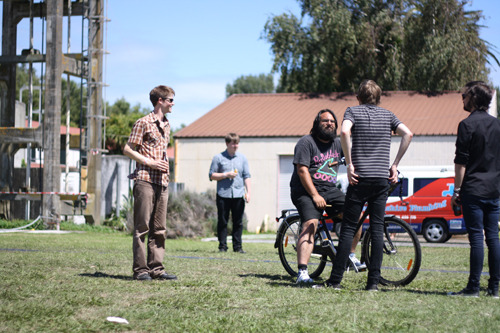
King of Camp, Blink on his bike.
Early afternoon was scorching hot, and we found as much shade as possible at “the assembly” in preparation for Grayson Gilmore & band. Sucking on blackcurrant juicies and bottled water kept us comfortable, but we were definitely envied our shady spot when the band played.
We’d had a bit too much fun with our vodka on day one, which meant a trip in to Bulls on the CALH bus ($1 return) to find more alcohol. Dinner came as a “tropical burger” from the local takeaway shop, where we were interrogated by the girl behind the counter about how many people were at Flock House and when Camp was advertised. None of the locals knew anything about it, and we got the sense that she resented their exclusion. Coming from a small town myself, I understood.
That afternoon back at Camp we heard a couple of band members having a heated post-performance conversation/bitchfest outside our window. We’re not sure who it was (maybe The Grass Cannons?), and I wish I’d recorded more of the conversation, it was pretty funny “it’s not because I’m drunk. I’m not that drunk… I’m just not”.
That night Laura and I sat in a central spot on our picnic blanket and drank cider and champagne from plastic cups, laughing and recognizing people by the nicknames we’d subconciously and affectionately given them. The Lank, 60’s couple, the Ginger, Beige Hat Guy, Bowl Cut, a handful of people we actually knew – and people who looked like people we knew… We played “snap” with those who walked past, and then got paranoid that people would notice we’d been sitting there for too long.

A collation of pictures taken from our picnic blanket spot. At the very least I caught Scarfies Guy and The Lank. Julian and Max in the blurry foreground – used to me taking pictures by now.
Disasteradio played the Pool at midnight and we watched from the back, where I couldn’t help but admire the work of the lighting tech. We watched red shirt guy and his shuffle dance, which didn’t change the whole set – but he was having a great time.
Another night on our dorm floor and we were ready for our routine of a frigid cold morning shower. This time, we persevered and waited for the shower with a door – rumored to have hot water. No one could work out how to get this mythical hot water flowing, but we had a chance to talk to other people waiting in line. One guy was over from Melbourne with his band, enjoying being around kiwis (apparently) and desperate to wash his (epic) beard properly.
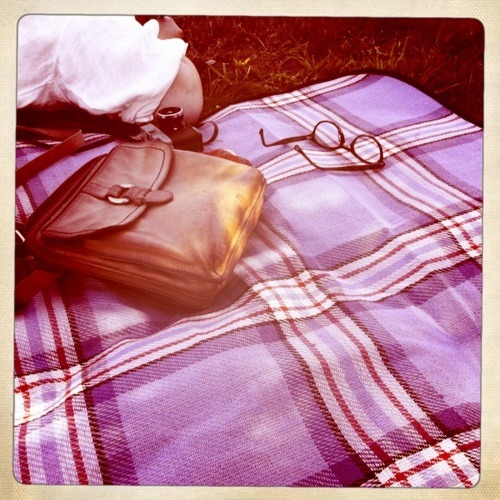
An afternoon spent in the shade.
By the time we’d finished showering we were definitely lacking stamina and weren’t feeling very social. We made notes and cards in the arts and crafts room, then found a gorgeous spot in the shade to lie in all afternoon.
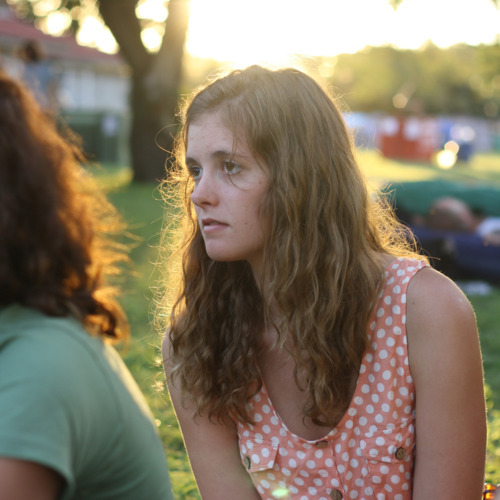
Taryn at sunset.
We pulled ourselves together to see Lawrence Arabia that evening, and after Caribou we finished our night with Four Tet in the Pool which was incredible. Again, the light show blew my mind and the Pool proved it’s worth as my favorite stage.
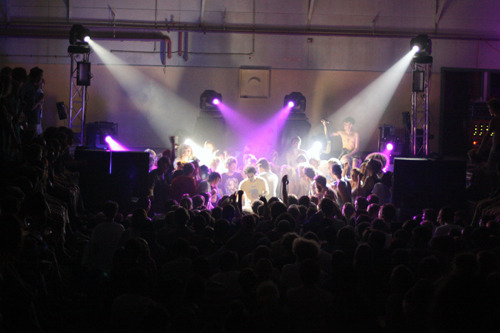
Four Tet in the pool.

Silhouette on the speaker while Four Tet plays the pool.
It was sad to pack up and leave Camp early on Monday morning, we were leaving behind a community of people we’d just shared an other-worldly three days with, and going back to our lives.
We sat again at Bulls’ bus station for two and a half hours, then packed into an Intercity bus back to Wellington, shellshocked, bleary eyed and tired. Neither of us minded the prospect of a real bed and a hot shower when we arrived in Wellington. And I had Webstock to get excited about.
If you are tossing up a trip to campus in 2012, Don’t hesitate. It’s worth every cent for the bands you’ll discover, the people you’ll meet, the relaxation and the many many good times.
—
Pictures were taken on my iPhone with Instagram, Hipstamatic, and Camera+, and my Canon 1000D. I haven’t got my films developed yet. As usual, more pictures over on Flickr.

















